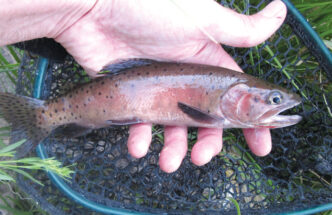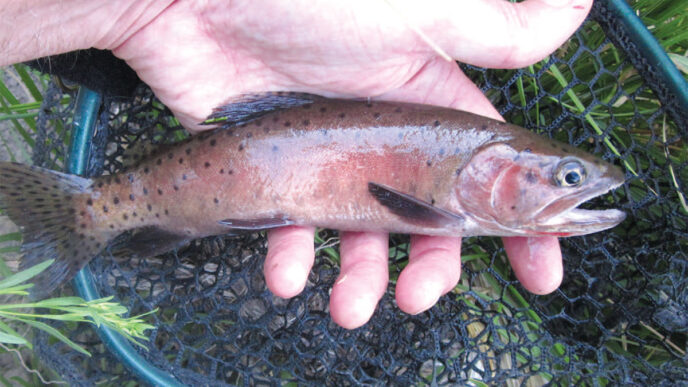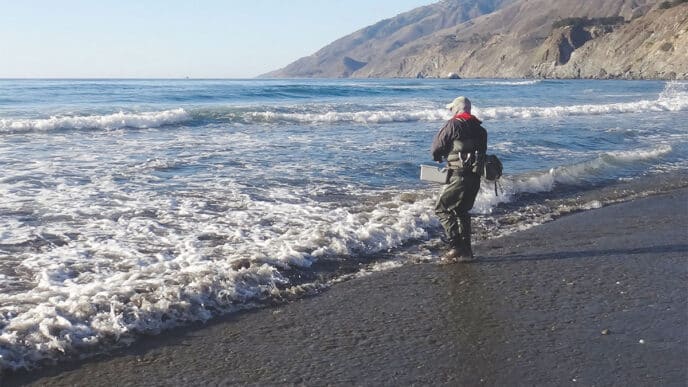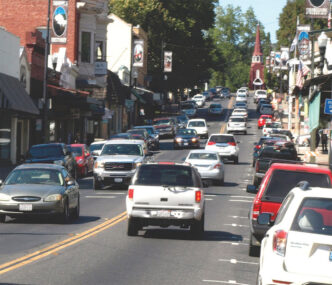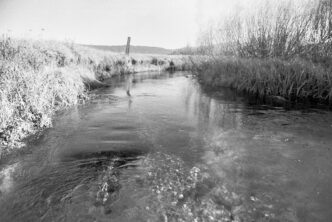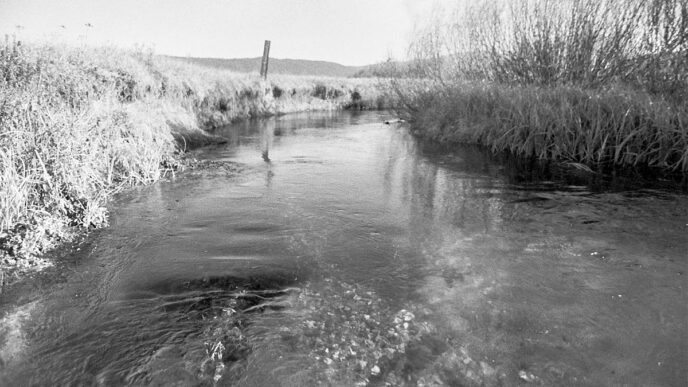Fish tacos lend themselves to camp cooking. Angling industry friend Frank Siefert, from Citrus Heights, leads a group to Iron Gate Reservoir each year around Memorial Day. There’s no limit on the abundant, tasty yellow perch that wind up in a group fish taco feed. These panfish are unique to Iron Gate in California and are at the top of our all-star flavor list. And last August, I was a guest of John and Jan Marcacci with the Tahoe Truckee Fly Fishers at Antelope Lake, near Susanville. We were all fly fishing for largemouth bass and kept a few fish for our annual Saturday night fish taco celebration. Combine the elements of fresh air and a beautiful setting with superb, unique food as well as good company, and you’ve got something special.
Whether tasty freshwater fish are available, such as largemouth or smallmouth bass, crappies, or catfish, or saltwater varieties such as Pacific rockfish, albacore tuna, calico bass, halibut, lingcod, greenlings, or even salmon, there will be excitement in camp. The nice thing is that you can cook your fish any number of ways. You might want to set up for deep frying, for grilling over a campfire, or for sautéing in a nonstick pan. (The latter two techniques will cut down on cleanup and the calories that come with deep frying.)
The real issue is oil or no oil, which is a health as well as logistical consideration. If you are with a larger group and want to do something special, you still might want to get out that kettle fish fryer, especially if you have fresh bass, crappies, albacore, or catfish and a good beer batter recipe. Occasionally, at home or in camp, when I have bass fillets from fish I’ve caught that day, I pull out a large wok and fry the fillets, which have been dredged in a thinned, seasoned tempura batter.
If you are going to deep fry your fish, use a vessel such as a cast iron Dutch oven. The high sides help contain the splatter, and the thick walls distribute and retain heat. Cook at 375 degrees and add the fish in increments so the temperature doesn’t drop with each new batch. Lower oil temperatures cause the fish to be greasy and soft. Don’t overbatter your fish. We want fish flavor, not batter flavor. For more on deep frying fish see the January/February 2013 “Foraging Angler” column, “Fish and Chips and Abalone Fritters.”
My wife and like to sauté our fish. In the past month, we used this method for Alaskan halibut, petrale sole, tilapia loins, and salmon fillets. If you use a high-quality nonstick skillet, you need very little oil and yet can obtain the caramelized surface texture with a bit of crunch that adds so much to the enjoyment of a meal. If pieces of fish vary in thickness, slice the larger ones horizontally to give them a uniform thickness; this will ensure that all chunks are done at the same time.
Any fish to be sautéed should be rinsed with cold water and patted dry, then tossed in a seasoned flour. Paprika and garlic salt work well here. Often I use Luzianne Cajun Seasoning for my spice mixture and always carry it in my camp kit. It works wonders for many foods without blowing out your taste buds. Drying the surface of the fish by patting with a towel and then tossing it in flour is what gives a golden brown surface texture. You are caramelizing the flour-fish interface of carbohydrate and protein. Even though high-end nonstick skillet companies say no oil is necessary, most good cooks add small amounts of oil and spread it with a bit of paper towel. Just a touch will give you that wonderful surface texture. If I’m using olive oil, I may add just a pat of unsalted butter for more flavor. Olive oil is fine if you keep the skillet temperatures on the moderate side. High temperatures such as are used in recipes for “blackened” fish will break down olive oil and make it taste bitter.
A great fish taco requires a great tortilla. The greasy, underfried taco shell of the past has given way to soft artisan tortillas that are heated on a grill or la plancha, in foil over a campfire grate, or crisped in a nonstick frying pan that has been wiped with small amount of mono-unsaturated oil. My first choice is always a fresh handmade tortilla right off the grill. Unfortunately these aren’t often available in camp, but can be found in homes and certain restaurants. Occasionally, when time is not a factor, I make my own using a recipe that I obtained at a cooking school in Merida, Yucatan. These heavenly tortillas are a little different from those found in other regions of Mexico and are called panuchos.
A major decision is whether we want a flour or corn tortilla and whether it is small, medium, or gigante, which are mainly used for burritos. Flour tortillas tend to be the same thickness and texture, but corn tortillas come in standard and artisan form (hand made) that are a bit thicker, and I’ve found hybrids made out of both flour and corn. One of my favorites is a medium-sized corn “green chili” creation. I’ve surveyed a number of grocery stores, and the big chains vary in what they stock. A good option is your local Hispanic market. You might just find the perfect tortilla that suits your taste buds, and the price is always right. I find that the ones in ziplock bags travel well and don’t dry out, probably because of preservatives. I use tortillas for almost anything that requires bread in camp, including breakfast. I favor corn tortillas, because they can be wrapped in foil and set on the edge of a campfire to warm and soften, not requiring a skillet or griddle.
I love fish tacos just about any way that they are made, and there as many recipes as cooks in Baja. Favorites are made with a variety of slaws. Slaws are great because you can be intuitive as well as creative and not need measured amounts. I usually head in an Asian direction when putting a slaw together and like to include daikon radish as well as thinly sliced red and white cabbage and sweet red onion. Beyond that, you can toss in just about any vegetable, and I like to use a mandoline to get matchstick-sized bits. Asian herbs such as Thai basil, plain old mint, and cilantro do wonders for a flavor profile. Finely diced, seeded jalapeños add a little heat and a subtle background taste. Carrots add crunch and sweetness, as does jicama sliced into little ribbons. Lime juice always helps.
I’ve found that slaws taste better if you toss them, as you would a green salad, with a small amount of something like a Chinese chicken salad dressing. You can use a dressing out of a bottle or make your own. In camp, I prefer premade dressings, which can be quite good, rather than having to carry many ingredients. It’s hard to beat Alder Market Sesame Spinach Dressing. Trader Joe’s has a decent Chinese chicken salad dressing. Avoid the ones with a high proportion of oil in the ingredient list. Often I prepare my slaw in advance and package it in zip-lock bags to cut down prep time on the first night in camp. To simplify further, you could use a prepackaged slaw mix and amp it up with your garnish.
Here is how Jan Marcacci cooked deep-fried fish tacos for our campfire meal at Antelope Lake: “The fish batter was a box mix. We used cold beer instead of the called-for water. Use canola oil and a cast iron Dutch oven for frying. The tortillas are heated over an open flame on a camp stove. Mixed shredded cabbage, diced onion, chopped tomato, and cilantro drizzled with squeezed lime juice.” What makes her fish tacos stand out is her “special dip’n sauce” — mayonnaise thinned with orange juice concentrate and seasoned with Tapatio hot sauce.
The beauty of this preparation is that the accoutrements do not overpower the incredible flavor and texture of the fresh, beer-battered fillets, and the “dip’n sauce” just raises the bar by marrying the flavors, without detracting from the fish. Other all-star possibilities for garnishes and sauces include ponzu sauce, cilantro sprigs, Sriracha hot sauce, Thai sweet chili sauce, D. L. Jardine’s Roasted Tomatillo Salsa, and avocado slices.
Put all this together at lakeside with a campfire and good company, and you have something very special that transcends ordinary food. As my good friend Capt’n Harry said, “There ain’t nothin’ better than breaking bread and sharing drink with good friends.”
Fresh Bass Recipe
Filet the fish, removing all bones. Beat one egg and add 1/2 cup buttermilk. Roll filets in it and then in a 50/50 mixture of cracker crumbs and Parmesan cheese. Salt and pepper both sides. Fry quickly in a medium-hot sauté pan one to two minutes per side depending on the thickness of the fillets. I hope you enjoy this as much as I do.
JB BRAHY
Via e-mail
The Dogwood Diner
By Ted Shapas
Running along a beautiful canyon parallel to Interstate 5, Dunsmuir has a renowned fly shop, a craftsman who will teach you how to make your own bamboo fly rod, a fishing guide who is also a ceramics artist, a bevy of interesting restaurants, a brewpub, diverse live music, the oldest hardware store in the state, and a railroad museum — all pretty amazing for a community with a population just north of 1,600. The big bonus, of course, is that the upper Sacramento River tumbles right through town, making Dunsmuir a great base camp for exploring many miles of incredible fishing water. But this story is about the Dogwood Diner, one of the newer restaurants to appear in Dunsmuir.
I stumbled onto this place last October during a fishing trip with two friends. Rumor was that the chef and restaurant name had changed and that it was worth a visit. The Dogwood Diner is in the historic building called Brown Trout, a somewhat ironic name, since what you are most likely to catch nearby will be rainbows. A vintage clothing and antique shop adjoins, with a window in its floor providing an osprey’s eye view of a tiny upper Sacramento tributary.

It was breakfast we were after, and the corned beef hash called out to us. Happily, it bore no resemblance to the canned kind, and instead was replete with giant chunks of juicy corned beef, arriving with two eggs (free-range, any style), a bowl of fresh fruit, and three choices for toast. One was the rare spelt variety, served up with a ramekin of jam, a welcome alternative to those pesky little plastic rectangles of jelly labeled “mixed berry,” as if someone forgot what went into them. Other distinctive breakfast offerings included pineapple French toast, two kinds of pancakes, panfried peanut-butter-stuffed cinnamon rolls, and a spin on the McMuffin called the Breakfast Sando.
On a recent road trip back from Seattle, my wife and I stopped there for lunch, where we split a tasty Mediterranean chicken panini and a bowl of hearty white bean and kale soup. The panini came with some of the best hand-cut fries we’ve ever had, paired nicely with house-made catsup topped with a dollop of garlic aioli. Several salads and other sandwiches rounded out the lunch menu. Dogwood offers more extensive dinner choices. They currently are open daily except for Wednesday and Thursday.
Recruited in 2012, executive chef Kate Chadwick is behind Dogwood’s innovations. You may recall her eponymous and successful restaurant, Hurricane Kate’s, in Eureka, California. Before that, she spent time in the restaurant biz in Denver, Flagstaff, and San Francisco, as well as on food-sampling travels through Japan, Israel, and Hawaii. To quote from Dogwood’s Web site (http://www.thedogwooddiner.com), Kate “is working with local ranchers, farmers, and culinary artisans to create a delicious and unique menu offering local, seasonal, farm-to-table, madefrom-scratch, gourmet California comfort food served 3 meals a day.”
On weekend evenings, you may get lucky beyond the good food. Last fall, my fishing companions and I found a lively four-piece bluegrass band playing in the back room of the Brown Trout. Cold beers and snacks were smoothly delivered from the Dogwood, while the friendly locals cut a mean rug in front of the stage. I even got fishing tips from the mandolin player!
The restaurant is at 5841 Sacramento Street, strategically located about a block from either the Ted Fay Fly Shop or the river. It opens at 8 A.M. and closes at 9 P.M. on Saturday and 8 P.M. on Sunday, Monday, Tuesday, and Friday. Phone (530) 6783502.
Lucky Breakfasts
By Kurt K. Colgan, Tightlinescafe.com
Fly fishing has many rituals. Some of the rituals are reverent, and some are not so reverent. Rituals bring luck. But is there a lucky breakfast? I’m certain that I’ve never caught a fish without first eating a lucky meal. Here are my luckiest breakfasts and how to fix or find them. Some are so lucky that they have to be made at home, others you can find when you’re on the road. If the public got wind of this lucky food, the rivers would be so crowded, and fishing would be so easy, it would no longer be a sport. It would be a calculated outing to catch fish, no trickery required.
KC’s Lucky Breakfast Sandwich. Don’t confuse KC’s lucky breakfast sandwich with an Egg McMuffin. McDonald’s doesn’t stock this much sausage at one time, so there is no way they can make it. This recipe is for two sandwiches.
1 pound Jimmy Dean or other highquality sausage, spicy or regular
4 slices of sprouted or high-fiber whole wheat bread
2 thick slices of sharp yellow or white cheddar
2 organic eggs Yellow mustard
Best Foods mayonnaise
Make two patties from the sausage, half a pound each. Fry them uncovered, but in a skillet that has a lid. While frying the sausage, toast the bread and, for each sandwich, put mayo on one slice and mustard on the other. Flip the sausage, and when it’s almost done, put a thick slice of cheese on each patty and put on the lid. When the cheese is melted, drain the patty and slide it onto a slice of the toasted bread. Fry the eggs, breaking the yolks. Put an egg on the sausage with the melted cheese, then put on the other piece of toast. Cut the sandwich in half and wrap it in foil so it stays warm. Do not eat this immediately! It should be eaten only on the way to the river, and I recommend waiting until you hit the freeway. You don’t want to be distracted by street signs while eating this monster.
Joe’s Scramble. Another one of my favorite lucky breakfasts is something I know as Joe’s scramble. This breakfast doesn’t travel well, so it’s best eaten in the lodge or in a restaurant. Mel’s Diner has a decent version. If you make it at home, here is my method. This is a very hearty breakfast, and this recipe is per person.
3 eggs, beaten
1/3 pound lean ground beef
1/2 cup onion, diced
1/4 cup good-quality grated Parmesan cheese
1/2 cup raw sliced mushrooms
1 cup baby spinach, chopped
1-1/2 tablespoons extra virgin olive oil
In a heavy skillet, brown the beef, drain it, and set it aside. Sauté the onion in one-half tablespoon of the olive oil for five minutes, until soft. Add the mushrooms and cook about three minutes more. Remove the mixture and set aside. Cut up the spinach into small pieces and sauté in onehalf tablespoon of olive oil. Add the remaining one-half tablespoon of olive oil to the skillet, return the beef to the pan, and heat on medium low to warm. Add the vegetables and stir. Beat the eggs and add to the mixture to scramble. Add the Parmesan cheese at the very end and serve immediately. Accompany with potatoes. Keep the Tabasco sauce handy!
Lucky Breakfasts on the Road. Another lucky breakfast is one of my all-time favorites: chicken-fried steak and eggs. Mel’s around Sacramento and Jax in Truckee have good versions. Jax’s chicken-fried steak is so big it hangs off the platter, a crunchy monster patty smothered in gravy. After eating at Jax, I take a minute to let the food settle. No hurry to get to the Truckee River anyway. It’s probably freezing outside, so I’ll just let the surface of the water warm a bit while I digest. There are 13 Mel’s Diners in Northern California. Check out http://www.originalmelsdiner.com/locations_hours.php. I visit the one at 13399 Folsom Boulevard, Folsom; phone (916) 985-7337. Jax “at the tracks,” 10144 West River Street, sits beside the railroad in downtown Truckee; phone (530) 550-7450.
If I’m headed up to Highway 65 to fish the Yuba or the Feather, I make a point of stopping at the Granite Rock Grill in Rocklin. I like their chicken apple sausage and their great array of pancakes. The Granite Rock Grill is at 5140 Pacific Street, Rocklin; phone (530) 625-9252.




